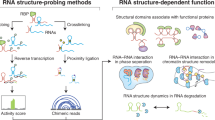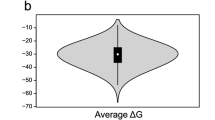Abstract
The structures of RNA molecules are often important for their function and regulation1,2,3,4,5,6, yet there are no experimental techniques for genome-scale measurement of RNA structure. Here we describe a novel strategy termed parallel analysis of RNA structure (PARS), which is based on deep sequencing fragments of RNAs that were treated with structure-specific enzymes, thus providing simultaneous in vitro profiling of the secondary structure of thousands of RNA species at single nucleotide resolution. We apply PARS to profile the secondary structure of the messenger RNAs (mRNAs) of the budding yeast Saccharomyces cerevisiae and obtain structural profiles for over 3,000 distinct transcripts. Analysis of these profiles reveals several RNA structural properties of yeast transcripts, including the existence of more secondary structure over coding regions compared with untranslated regions, a three-nucleotide periodicity of secondary structure across coding regions and an anti-correlation between the efficiency with which an mRNA is translated and the structure over its translation start site. PARS is readily applicable to other organisms and to profiling RNA structure in diverse conditions, thus enabling studies of the dynamics of secondary structure at a genomic scale.
This is a preview of subscription content, access via your institution
Access options
Subscribe to this journal
Receive 51 print issues and online access
$199.00 per year
only $3.90 per issue
Buy this article
- Purchase on Springer Link
- Instant access to full article PDF
Prices may be subject to local taxes which are calculated during checkout




Similar content being viewed by others
References
Arava, Y. et al. Genome-wide analysis of mRNA translation profiles in Saccharomyces cerevisiae . Proc Natl Acad Sci USA 100, 3889–3894 (2003)
Wang, Y. et al. Precision and functional specificity in mRNA decay. Proc. Natl Acad. Sci. USA 99, 5860–5865 (2002)
Takizawa, P. A., DeRisi, J. L., Wilhelm, J. E. & Vale, R. D. Plasma membrane compartmentalization in yeast by messenger RNA transport and a septin diffusion barrier. Science 290, 341–344 (2000)
Shepard, K. A. et al. Widespread cytoplasmic mRNA transport in yeast: identification of 22 bud-localized transcripts using DNA microarray analysis. Proc. Natl Acad. Sci. USA 100, 11429–11434 (2003)
Tucker, B. J. & Breaker, R. R. Riboswitches as versatile gene control elements. Curr. Opin. Struct. Biol. 15, 342–348 (2005)
Kertesz, M., Iovino, N., Unnerstall, U., Gaul, U. & Segal, E. The role of site accessibility in microRNA target recognition. Nature Genet. 39, 1278–1284 (2007)
Ziehler, W. A. & Engelke, D. R. in Current Protocols in Nucleic Acid Chemistry Ch. 6, Unit 6.1 (John Wiley, 2001)
Rinn, J. L. et al. Functional demarcation of active and silent chromatin domains in human HOX loci by noncoding RNAs. Cell 129, 1311–1323 (2007)
Guo, F., Gooding, A. R. & Cech, T. R. Structure of the Tetrahymena ribozyme: base triple sandwich and metal ion at the active site. Mol. Cell 16, 351–362 (2004)
Chartrand, P., Meng, X. H., Huttelmaier, S., Donato, D. & Singer, R. H. Asymmetric sorting of ash1p in yeast results from inhibition of translation by localization elements in the mRNA. Mol. Cell 10, 1319–1330 (2002)
Reineke, L. C., Komar, A. A., Caprara, M. G. & Merrick, W. C. A small stem loop element directs internal initiation of the URE2 internal ribosome entry site in Saccharomyces cerevisiae . J. Biol. Chem. 283, 19011–19025 (2008)
Hofacker, I. L., Fekete, M. & Stadler, P. F. Secondary structure prediction for aligned RNA sequences. J. Mol. Biol. 319, 1059–1066 (2002)
Watts, J. M. et al. Architecture and secondary structure of an entire HIV-1 RNA genome. Nature 460, 711–716 (2009)
Mathews, D. H. et al. Incorporating chemical modification constraints into a dynamic programming algorithm for prediction of RNA secondary structure. Proc. Natl Acad. Sci. USA 101, 7287–7292 (2004)
Shabalina, S. A., Ogurtsov, A. Y. & Spiridonov, N. A. A periodic pattern of mRNA secondary structure created by the genetic code. Nucleic Acids Res. 34, 2428–2437 (2006)
Ingolia, N. T., Ghaemmaghami, S., Newman, J. R. S. & Weissman, J. S. Genome-wide analysis in vivo of translation with nucleotide resolution using ribosome profiling. Science 324, 218–223 (2009)
Kozak, M. Regulation of translation via mRNA structure in prokaryotes and eukaryotes. Gene 361, 13–37 (2005)
Kudla, G., Murray, A. W., Tollervey, D. & Plotkin, J. B. Coding-sequence determinants of gene expression in Escherichia coli . Science 324, 255–258 (2009)
Ashburner, M. et al. Gene ontology: tool for the unification of biology. The Gene Ontology Consortium. Nature Genet. 25, 25–29 (2000)
Palazzo, A. F. et al. The signal sequence coding region promotes nuclear export of mRNA. PLoS Biol. 5, e322 (2007)
Acknowledgements
We thank D. Herschlag’s group, A. Adler, A. Fire, M. Kay, the Life Technologies SOLiD team, M. Rabani, G. Sherlock and A. Weinberger for assistance and critiques. This work was supported by a National Institutes of Health grant (RO1HG004361). Y.W. is funded by the Agency of Science, Technology and Research of Singapore. H.Y.C. is an Early Career Scientist of the Howard Hughes Medical Institute. E.S. is the incumbent of the Soretta and Henry Shapiro career development chair.
Author information
Authors and Affiliations
Contributions
M.K., J.L.R., H.Y.C. and E.S. conceived the project; Y.W. and H.Y.C. developed the protocol and designed the experiments; Y.W. performed all experiments; M.K., E.M. and E.S. planned and conducted the data analysis; J.L.R. and R.C.N. helped with sequencing; M.K., Y.W., E.M., H.Y.C. and E.S. wrote the paper with contributions from all authors.
Corresponding authors
Ethics declarations
Competing interests
The authors declare no competing financial interests.
Supplementary information
Supplementary Information
This file contains Supplementary Methods and Data, a Supplementary Note, additional references, Supplementary Figures 1-16 with legends and Supplementary Tables 1, 2 and 4 (see separate files for Supplementary Tables 3 and 5). (PDF 1680 kb)
Supplementary Table 3
This table lists all genes whose average nucleotide coverage is above 1.0 (Methods). Columns show, for each gene, the annotated transcript length, the total number of sequences mapping to that transcript, the computed load and the type of transcript: mRNA, rRNA, snoRNA, tRNA, snRNA or ncRNA. (XLS 322 kb)
Supplementary Table 5
This file contains sub-tables which list the Wilcoxon rank sum test p-value for each GO term when genes were sorted based on their average PARS score in each region of the transcript (5’ UTR, CDS, 3’ UTR). For each group, the FDR correction p-value threshold is indicated, and GO categories having a p-value below this threshold are marked in green. (XLS 44 kb)
Rights and permissions
About this article
Cite this article
Kertesz, M., Wan, Y., Mazor, E. et al. Genome-wide measurement of RNA secondary structure in yeast. Nature 467, 103–107 (2010). https://doi.org/10.1038/nature09322
Received:
Accepted:
Issue Date:
DOI: https://doi.org/10.1038/nature09322
This article is cited by
-
Single-molecule visualization of mRNA circularization during translation
Experimental & Molecular Medicine (2023)
-
Systematic detection of tertiary structural modules in large RNAs and RNP interfaces by Tb-seq
Nature Communications (2023)
-
Genome-wide probing of eukaryotic nascent RNA structure elucidates cotranscriptional folding and its antimutagenic effect
Nature Communications (2023)
Comments
By submitting a comment you agree to abide by our Terms and Community Guidelines. If you find something abusive or that does not comply with our terms or guidelines please flag it as inappropriate.



